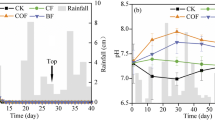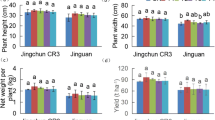Abstract
Enhancing nitrogen productivity and economic benefits are the key for organic vegetable production across the Northwest China. Through three cropping cycles in net house, changes under organic fertilizer (composited cow dung) in combination with different level of corn cobs biochar (BC) in soil mineral nitrogen, growth, yield, nitrogen use efficiency and economic benefits of Organic Chinese Flowering Cabbage (OFCC) were examined. The treatments included: 110.0 t ha−1 organic fertilizer (OF), combination of OF and 8.5 t ha−1 BC (OF + B8.5), combination of OF and 17.0 t ha−1 BC (OF + B17), no OF and BC as control (CK). Results showed that highest vegetative sprouts long and crude, yield and N uptake were obtained from the OF + B8.5. Total annual yield and N uptake of OFCC increased by 43.5% and 47.6% (p < 0.05), respectively, for OF + B8.5 compared with the OF. Meanwhile, OF + B8.5 provided exerted a 52.2% increase in nitrogen agronomic efficiency and 42.3% increase in net income over the OF. However, the OF + B17 did not exert positive effects. These benefits of BC could be attributed partly to mitigation of N leaching as indicated by higher NO3− content in the topsoil and reduced content in the subsoil. In OF + B17, a higher soil NO3− content was measured, however, this did not bring to a higher yield due to nitrogen availability reduced by BC surface functional groups and soil higher C/N relative to that of OF + B8.5. We conclude that application of small amounts of BC can allow farmers to receive higher net income via increased yields.



Similar content being viewed by others
Abbreviations
- OFCC:
-
Organic Chinese Flowering Cabbage
- BC:
-
Biochar
References
Agegnehu G, Liben M, Molla A, Feyissa A, Bekele A, Getaneh F (2011) Research achievements in soil fertility management in relation to barley in Ethiopia. In: Mulatu B, Grando S (eds) Barley research and development in Ethiopia. ICARDA, Addis Ababa, pp 137–152
Agegnehu G, Nelson PN, Bird MI (2016a) The effects of biochar, compost and their mixture and nitrogen fertilizer on yield and nitrogen use efficiency of barley grown on a Nitisol in the highlands of Ethiopia. Sci Total Environ 569–570:869–879
Agegnehu G, Nelson PN, Bird FMI (2016b) Crop yield, plant nutrient uptake and soil physicochemical properties under organic soil amendments and nitrogen fertilization on Nitisols. Soil Tillage Res 160:1–13
Angst TE, Six J, Reay DS, Sohi SP (2014) Impact of pine chip biochar on trace greenhouse gas emissions and soil nutrient dynamics in an annual ryegrass system in California. Agric Ecosyst Environ 191:17–26
Bian R, Joseph S, Cui L, Pan G, Li L, Liu X, Zhang A, Rutlidge H, Wong S, Chia C, Marjo C, Gong B, Munroe P, Donne S (2014) A three-year experiment confirms continuous immobilization of cadmium and lead in contaminated paddy field with biochar amendment. J Hazard Mater 272:121–128
Cassman KG, Munns DN (1980) Nitrogen mineralization as affected by soil moisture, temperature, and depth. Soil Sci Soc Am J 44:1233–1237
Gharous M, Westerman RL, Soltanpour PN (1990) Nitrogen mineralization potential of arid and semiarid soils of Morocco. Soil Sci 54:438–443
Glaser B, Haumaier L, Guggenberger G, Zech W (2001) The ‘Terra Preta’ phenomenon: a model for sustainable agriculture in the humid tropics. Die Naturwissenschaften 88:37–41
Gong Z (1999) Chinese soil taxonomy. China Science Press, Beijing, pp 109–192 (in Chinese)
Haider G, Koyro H, Azam F, Steffens D, Müller C, Kammann C (2015) Biochar but not humic acid product amendment affected maize yields via improving plant-soil moisture relations. Plant Soil 395:141–157
Haider G, Steffens D, Müller C, Kammann CI (2016) Standard extraction methods may underestimate nitrate stocks captured by field-aged biochar. J Environ Qual 45:1196
Haider G, Steffens D, Moser G, Müller C, Kammann CI (2017) Biochar reduced nitrate leaching and improved soil moisture content without yield improvements in a four-year field study. Agric Ecosyst Environ 237:80–94
Hangs RD, Ahmed HP, Schoenau JJ (2016) Influence of willow biochar amendment on soil nitrogen availability and greenhouse gas production in two fertilized temperate prairie soils. BioEnergy Res 9:157–171
Hongdi H, Yansong Z, Hua Z, Xiangyang L (2008) Effect of dashennong leaf fertilizer on the production and characteristics of Flowering Chinese Cabbage. J Changjiang Veg 7:69–70 (in Chinese with English abstract)
Hossain MK, Strezov V, Chan KY, Nelson PF (2010) Agronomic properties of wastewater sludge biochar and bioavailability of metals in production of cherry tomato (Lycopersicon esculentum). Chemosphere 78:1167–1171
Joseph S, Graber ER, Chia C, Munroe P, Donne S, Thomas T, Nielsen S, Marjo C, Rutlidge H, Pan GX, Li L, Taylor P, Rawal A, Hook J (2014) Shifting paradigms: development of high-efficiency biochar fertilizers based on nano-structures and soluble components. Carbon Manag 4:323–343
Ju XT, Kou CL, Zhang FS, Christie P (2006) Nitrogen balance and groundwater nitrate contamination: comparison among three intensive cropping systems on the North China Plain. Environ Pollut 143:117–125
Keeney D, Nelson D (1982) Nitrogen-inorganic forms. In: Page AL (ed) Methods of soil analysis part 2. Soil Science Society of America, Madison, pp 643–698
Lehmann J, Da Silva JP, Steiner C, Nehls T, Zech W, Glaser B (2003) Nutrient availability and leaching in an archaeological Anthrosol and a Ferralsol of the Central Amazon basin: fertilizer, manure and charcoal amendments. Plant Soil 249:343–357
Liu H, Duan A, Li F, Sun J, Wang Y, Sun C (2013a) Drip irrigation scheduling for tomato grown in solar greenhouse based on pan evaporation in North China Plain. J Integr Agric 12:520–531
Liu X, Zhang A, Ji C, Joseph S, Bian R, Li L, Pan G, Paz-Ferreiro J (2013b) Biochar’s effect on crop productivity and the dependence on experimental conditions-a meta-analysis of literature data. Plant Soil 373:583–594
Lu R (2000) Methods of soil and agro-chemical analysis. China Agricultural Science and Technology Press, Beijing (in Chinese)
Marousek J (2014) Significant breakthrough in biochar cost reduction. Clean Technol Environ Policy 16:1821–1825
Morris OO, Xia X, Nahayo A, Liu X, Korai PK, Pan G (2016) Quantification of biochar effects on soil hydrological properties using meta-analysis of literature data. Geoderma 274:28–34
National Bureau of Statistics of the People’s Republic of China (NBS) (2016). http://data.stats.gov.cn/search.htm?s=. (in Chinese)
National Development and Reform Commission, the People’s Republic of China (NDRC) (2015) Promotion directory national key low-carbon technologies. http://www.sdpc.gov.cn/gzdt/201512/W020151218515971721542.pdf. (in Chinese)
Ruliang L, Youhong L, Fang W, Tiancheng Z, Cheng C, Yu H (2016) The study on rice organic fertilizer suitable application amount in Yellow River irrigation area of Ningxia. Ningxia J Agric For Sci Technol 7:1–2 (in Chinese with English abstract)
Rütting T, Aronsson H, Delin S (2018) Efficient use of nitrogen in agriculture. Nutr Cycl Agroecosyst 110:1–5
Sánchez-García M, Alburquerque JA, Sánchez-Monedero MA, Roig A, Cayuela ML (2015) Biochar accelerates organic matter degradation and enhances N mineralisation during composting of poultry manure without a relevant impact on gas emissions. Bioresour Technol 192:272–279
Vaccari FP, Baronti S, Lugato E, Genesio L, Castaldi S, Fornasier F, Miglietta F (2011) Biochar as a strategy to sequester carbon and increase yield in durum wheat. Eur J Agron 34:231–238
Wenbin W, Zhanfeng G (2012) Meteorological factors affecting the growth of vegetables. J Anhui Agric Sci 40(17202–17203):17211 (in Chinese with English abstract)
Willer H, Lernoud J (2014) The world of organic agriculture statistics and emerging trends. Nürnberg: Research Institute of Organic Agriculture, Frick and International Federation of Organic Agriculture Movements, pp 1–7. https://www.fibl.org/de/startseite.html
Wu H, Yip K, Kong Z, Li C, Liu D, Yu Y, Gao X (2011) Removal and recycling of inherent inorganic nutrient species in Mallee biomass and derived biochars by water leaching. Ind Eng Chem Res 50:12143–12151
Xinlin S, Jisun Q, Lijuan Z, Qiannan Z, Li M, Changxin Y, Lindan H (2017) Effects of different organic fertilizer on pepper growth in new irrigation areas by pumping Yellow River. Ningxia J Agric For Sci Technol 58:11–13 (in Chinese with English abstract)
Zhang A, Cui L, Pan G, Li L, Hussain Q, Zhang X, Zheng J, Crowley D (2010) Effect of biochar amendment on yield and methane and nitrous oxide emissions from a rice paddy from Tai Lake plain, China. Agric Ecosyst Environ 139:469–475
Zhang D, Pan G, Wu G, Kibue GW, Li L, Zhang X, Zheng J, Zheng J, Cheng K, Joseph S, Liu X (2016) Biochar helps enhance maize productivity and reduce greenhouse gas emissions under balanced fertilization in a rainfed low fertility inceptisol. Chemosphere 142:106–113
Zheng H, Wang Z, Deng X, Herbert S, Xing B (2013) Impacts of adding biochar on nitrogen retention and bioavailability in agricultural soil. Geoderma 206:32–39
Zheng J, Han J, Liu Z, Xia W, Zhang X, Li L, Liu X, Bian R, Cheng K, Zheng J, Pan G (2017) Biochar compound fertilizer increases nitrogen productivity and economic benefits but decreases carbon emission of maize production. Agric Ecosyst Environ 241:70–78
Acknowledgements
We acknowledge and are grateful the financial support provided by National Natural Science foundation of China (41501312), the National Science and Technology Pillar Program during the 12th 5-year Plan Period (2014BAD05B02) and Beijing Natural Science Foundation (6182012).
Author information
Authors and Affiliations
Corresponding author
Electronic supplementary material
Below is the link to the electronic supplementary material.
Rights and permissions
About this article
Cite this article
Wang, Z., Li, Yk., Guo, Wz. et al. Yield, nitrogen use efficiency and economic benefits of biochar additions to Chinese Flowering Cabbage in Northwest China. Nutr Cycl Agroecosyst 113, 337–348 (2019). https://doi.org/10.1007/s10705-019-09971-6
Received:
Accepted:
Published:
Issue Date:
DOI: https://doi.org/10.1007/s10705-019-09971-6




